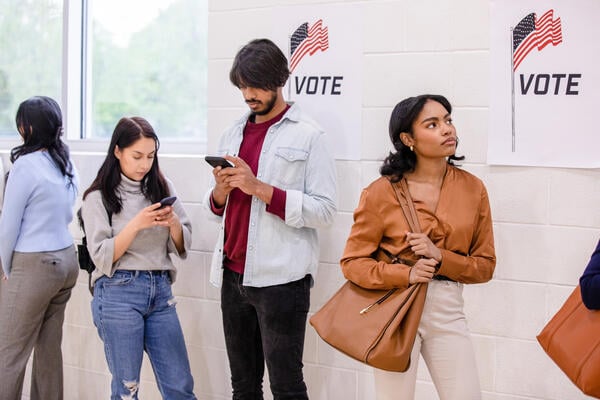
4 Times Colleges Led the Fight for Voting Rights (opinion)
Student voting offers a special test and opportunity for American institutions of higher education, which are in the midst of an authoritarian assault not seen since the McCarthy era. Since before the Revolution, American leaders have celebrated the link between higher education, service to the nation and democracy. In 1947, the Truman Commission declared that “The first and most essential charge upon higher education is that at all its levels and in all its fields of specialization it shall be the carrier of democratic values, ideals and processes.”
Numerous American colleges and universities invoke a form of civic purpose in their mission statements. Harvard College seeks to “educate the citizens and citizen-leaders for our society.” Princeton University is committed “to prepare students for lives of service, civic engagement and ethical leadership” in order to “serve the nation and the world.” Stanford University prepares students for “leadership and engaged citizenship in the world.”
Yet at this moment, one often feels what Martin Luther King, Jr. described in his 1957 “Give Us the Ballot” speech as a “high blood pressure of words and an anemia of deeds.” Many institutions make only a passive attempt to register student voters and refuse to engage institutionally when students’ rights are violated. For example, during the most recent midterm elections in 2022, students from an organization called Ivy League Votes complained that college administrators told them that it is “beneficial for students to face barriers to voting” while in college so they could get used to challenges they would face after graduation.
Impediments to college students’ electoral participation promise only to grow, with the Trump administration threatening to impose numerous restrictions to voter registration through the SAVE Act and a series of executive orders, while state legislators are increasingly imposing new hurdles, such as restrictive identification and proof of residency requirements, that are particularly impactful on young and mobile voters.
With the 55th anniversary of the 26th Amendment, which lowered the age of voting from 21 to 18, nearly upon us, it is time for U.S. colleges to defend the most foundational of democratic rights, the right to vote. In so doing they will reaffirm the link between higher education and democracy.
Our new book, Youth Voting Rights: Civil Rights, the Twenty-Sixth Amendment, and the Fight for American Democracy on College Campuses (De Gruyter Brill), tells the story of how different constituencies within college communities, often acting in concert with each other and voter advocacy and legal defense organizations, have fought for the right to vote. The book is centered on case studies of four institutions with challenging voting rights histories: Tuskegee University in Alabama (formerly the Tuskegee Institute), Prairie View A&M University in Texas, North Carolina A&T State University and Bard College in upstate New York.
Much of the book is devoted to experiences of historically Black colleges and universities, which spent decades fighting a special American form of authoritarianism: the Jim Crow South. The lessons of the cases show how resistance is possible and that core university constituencies—faculty, staff and institutional leaders—can play a critical role in both defending students’ rights locally and simultaneously expanding those rights for the nation.
Students. Prairie View A&M offers a model for how students can channel their idealism and determination into action. Their initial battle centered on restrictive residency requirements and targeted questionnaires in Waller County, Tex. The right of PVAMU students to vote locally was ultimately affirmed in the 1979 Symm v. the United States precedential decision, the only U.S. Supreme Court decision grounded in the 26th Amendment.
Since then, PVAMU student leaders have mobilized to fight regular attempts at voter suppression, which often included long marches to the county seat. In 1992, they defended the Prairie View 19, who were arrested for alleged voter fraud in the midst of an election in which two Black PVAMU alumni were poised to win local elections. In 2004, they mobilized when a local district attorney ignored Symm and threatened students with prosecution over residency violations. In 2008, 2012–13 and 2018 they fought over accessible poll sites for regular and early voting, including for a polling place on campus. To this day, the defense of voting rights is an essential function of PVAMU student government.
Faculty. For faculty, Tuskegee Institute sociologist Charles Gomillion offers an archetype for perseverance. Gomillion founded the Tuskegee Civic Association, which attempted to register Black voters who were systematically disenfranchised, including many distinguished faculty of Tuskegee Institute and employees of a local veterans’ hospital. When the powers that be in Alabama feared that Tuskegee Blacks were becoming too successful, the Legislature in 1957 gerrymandered nearly the entire Black population out of the municipality, including the entire Tuskegee Institute, converting the boundaries from a neat square into what was likened to a 28-sided sea serpent.
Gomillion and the TCA initiated a boycott and sued, with Gomillion becoming the named litigant in the landmark 1960 Supreme Court decision Gomillion v. Lightfoot, which invoked the 15th Amendment to nullify the map. The case reverberated nationally, with members of the TCA, including Tuskegee professors and staff, amongst the first people to testify before the newly established U.S. Commission on Civil Rights. They offered academic research documenting their plights, along with practical solutions, which helped to pave the way for the Civil Rights Act of 1960 and the Voting Rights Act of 1965.
Institutions. Bard College in upstate New York demonstrated the importance of institutional leadership. When in the late 1990s a student group mobilized with students from Vassar College to fight the Dutchess County Board of Elections, which simply refused to allow college students to register to vote locally, the Bard Board of Trustees weighed in and senior college administrators joined students and faculty in what was a successful mobilization to force the BOE to change its practices.
Over the next dozen years, the Bard board supported, and in some cases financed, successful litigation in state and federal court to force the Board of Elections to accept student registrations and count student votes. When the fight shifted to a polling place on campus, Bard’s longtime president Leon Botstein joined other administrators and students as litigants in a series of successful lawsuits to establish a polling place on the Bard campus. Senior Bard administrators then worked with students and a network of good government organizations to pass a state law providing for polling places on or near college campuses with 300 or more registered voters.
What are the lessons of these histories for universities today?
First, universities can and have stood against authoritarianism. As Jelani M. Favors argues in his excellent history of HBCUs, Shelter in a Time of Storm (UNC Press, 2020), HBCUs have contributed to the social and civic development of their own communities, and, when the moment allowed, mobilized nationally in the fight for civil rights during the Second Reconstruction. Nowhere was this more evident than at Favors’s alma mater, N.C. A&T. The A&T (Greensboro) Four, who demanded service at the Woolworth’s lunch counter, inspired generations of students, including N.C. A&T students who successfully fought a 2016 gerrymandering effort to sunder the campus into two separate congressional districts.
Second, core university constituencies, including students, faculty, staff and institutional leaders, up to the president and members of the board of trustees, can defend democratic rights, often in cooperation with other institutions within civil society. Engagement works best when all constituencies are working in concert, but each constituency can serve as a civic actor in its own right.
Third, universities and university leaders in particular should clearly stand behind the most foundational of democratic rights, the right to vote. Studies show that voting is habit-forming and that young voters continue to vote throughout their lifetimes. With states and the federal government throwing up barriers, higher education institutions can act passively or take steps to promote registration and voting and defend students against violations of their rights. They should not simply make rhetorical commitments to the importance of civic engagement and the link between higher education and democracy, but align their deeds with their words and use institutional resources—moral, intellectual, financial—to resist violation of democratic rights and support core democratic principles, including voting rights.
Finally, students, the most important constituency within a university ecosystem, should continue to play an important role. As PVAMU student organizer Jayla Allen put it, “One thing I always said is that we’re watching, we’re listening, we want to be involved, we know that we are the future, we know that we can have the impact to make the changes that we need … [to make the] world that we want to see.”
The lesson of the case studies is not that voting and democracy are synonymous, but that members of college communities, including students, have agency and have the capacity to deploy the tools of democracy to promote equity and advance democratic freedoms in the hope of a better future.
It is no surprise, then, that many of the students involved in the case studies we explore in our book went on to graduate and become leading public servants. They learned how to work under pressure to build coalition and consensus, advance civic dialogue, research, advocate, and productively contribute to social change, and they did so alongside faculty and college administrators. The fight against authoritarianism is one steeped in a think-and-do pedagogy, which historically aligns with the missions of institutions of higher education and contributes to safeguarding the nation’s future.
Source link



